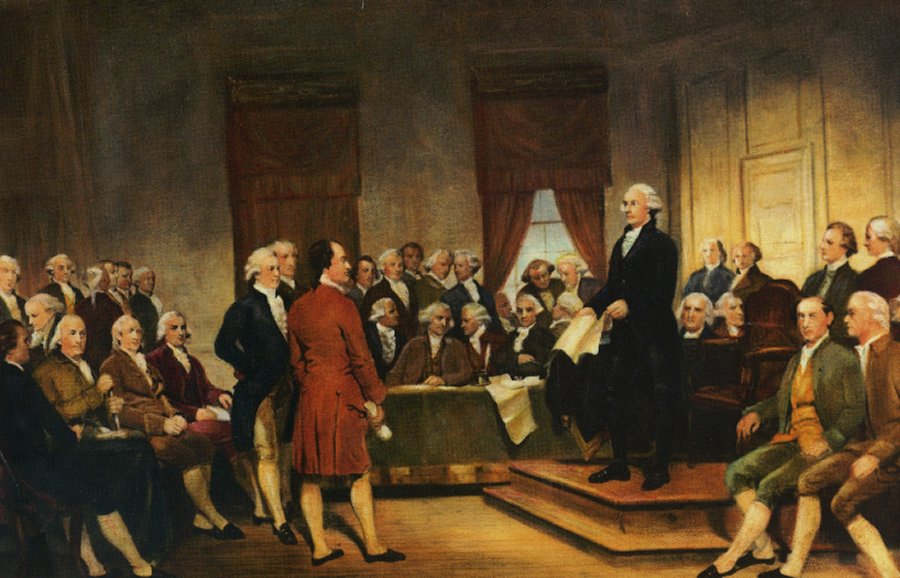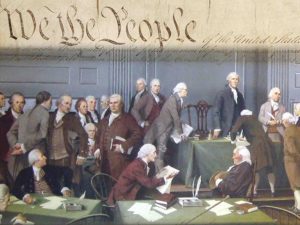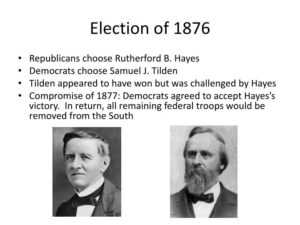Feb
2
Why We Must Preserve the Electoral College, part 1 of 2
Why not a national popular vote for president?
That’s the question a lot of Americans are asking these days, and it’s the one addressed by Trent England in a speech last April at Hillsdale College.* England is EVP and the David and Ann Brown Distinguished Fellow at the Oklahoma Council of Public Affairs, where he also directs the Save Our States project. What follows is a slightly abbreviated version of Hillsdale’s own adaptation of the speech:

Delegates to the Constitutional Convention in 1787 asked themselves the same question, but then rejected a national popular vote along with several other possible modes of presidential election. The Virginia Plan — the first draft of what would become the new Constitution — called for “a National Executive… to be chosen by the National Legislature.” … Delegates did not support the Virginia Plan’s parliamentary model because they understood that an executive selected by Congress would become subservient to Congress. A similar result, they came to see, could be expected from assigning the selection to any body of politicians….
By July 25, it was clear to James Madison that the choice was down to two forms of popular election: ‘The option before us,’ he said, ‘[is] between an appointment by Electors chosen by the people — and an immediate appointment by the people.’ Madison said he preferred popular election, but he recognized two legitimate concerns. First, people would tend toward supporting candidates from their own states, giving an advantage to larger states. Second, a few areas with higher concentrations of voters might come to dominate. Madison spoke positively of the idea of an electoral college, finding that ‘there would be very little opportunity for cabal, or corruption’ in such a system.
By August 31, the Constitution was nearly finished — except for the process of electing the president. The question was put to a committee comprised of one delegate from each of the eleven states present at the Convention. That committee, which included Madison, created the Electoral College as we know it today. They presented the plan on September 4, and it was adopted with minor changes. It is found in Article II, Section 1:
Each State shall appoint, in such Manner as the Legislature thereof may direct, a Number of Electors, equal to the whole Number of Senators and Representatives to which the State may be entitled in the Congress.

Federal officials were prohibited from being electors. Electors were required to cast two ballots, and were prohibited from casting both ballots for candidates from their own state. A deadlock for president would be decided by the House of Representatives, with one vote per state. Following that, in case of a deadlock for vice president, the Senate would decide. Also under the original system, the runner up became vice president. [After this last provision caused much grief for both John Adams and Thomas Jefferson, the Twelfth Amendment (1804) fixed it] by requiring electors to cast separate votes for president and vice president.
And there things stand, constitutionally at least. State legislatures have used their power to direct the manner of choosing electors in various ways: appointing them directly, holding elections by district, or holding statewide elections. Today, 48 states choose their presidential electors in a statewide, winner-take-all vote. Maine and Nebraska elect one elector based on each congressional district’s vote and the remaining two based on the statewide vote.
It is easy for Americans to forget that when we vote for president, we are really voting for electors who have pledged to support the candidate we favor. Civics education is not what it used to be. Also, perhaps, the Electoral College is a victim of its own success. Most of the time, it shapes American politics in ways that are beneficial but hard to see. Its effects become news only when a candidate and his or her political party lose a hard-fought and narrowly decided election.
So what are the beneficial effects of choosing our presidents through the Electoral College?

Under the Electoral College system, presidential elections are decentralized, taking place in the states. Although some see this as a flaw — U.S. Senator Elizabeth Warren opposes the Electoral College expressly because she wants to increase federal power over elections — this decentralization has proven to be of great value.
For one thing, state boundaries serve a function analogous to that of watertight compartments on an ocean liner. Disputes over mistakes or fraud are contained within individual states. Illinois can recount its votes, for instance, without triggering a nationwide recount. This was an important factor in America’s messiest presidential election — which was not in 2000, but in 1876.
That year marked the first time a presidential candidate won the electoral vote while losing the popular vote. It was a time of organized suppression of black voters in the South, and there were fierce disputes over vote totals in Florida, Louisiana, and South Carolina. Each of those states sent Congress two sets of electoral vote totals, one favoring Republican Rutherford Hayes and the other Democrat Samuel Tilden. Just two days before Inauguration Day, Congress finished counting the votes — which included determining which votes to count — and declared Hayes the winner. Democrats proclaimed this ‘the fraud of the century,’ and there is no way to be certain today — nor was there probably a way to be certain at the time — which candidate actually won. At the very least, the Electoral College contained these disputes within individual states so that Congress could endeavor to sort it out. And it is arguable that the Electoral College prevented a fraudulent result.
Four years later, the 1880 presidential election demonstrated another benefit of the Electoral College system: it can act to amplify the results of a presidential election. The popular vote margin that year was less than 10,000 votes — about one-tenth of one percent — yet Republican James Garfield won a resounding electoral victory, with 214 electoral votes to Democrat Winfield Hancock’s 155. There was no question who won, let alone any need for a recount. More recently, in 1992, the Electoral College boosted the legitimacy of Democrat Bill Clinton, who won with only 43 percent of the popular vote but received over 68 percent of the electoral vote.

But there is no doubt that the greatest benefit of the Electoral College is the powerful incentive it creates against regionalism. Here, the presidential elections of 1888 and 1892 are most instructive. In 1888, incumbent Democratic President Grover Cleveland lost reelection despite receiving a popular vote plurality. He won this plurality because he won by very large margins in the overwhelmingly Democratic South. He won Texas alone by 146,461 votes, for instance, whereas his national popular vote margin was only 94,530. Altogether he won in six southern states with margins greater than 30 percent, while only tiny Vermont delivered a victory percentage of that size for Republican Benjamin Harrison. In other words, the Electoral College ensures that winning supermajorities in one region of the country is not sufficient to win the White House….
Whether we see it or not today, the Electoral College continues to push parties and presidential candidates to build broad coalitions. Critics say that swing states get too much attention, leaving voters in so-called safe states feeling left out. But the legitimacy of a political party rests on all of those safe states — on places that the party has already won over, allowing it to reach farther out. In 2000, for instance, George W. Bush needed every state that he won — not just Florida — to become president. Of course, the Electoral College does put a premium on the states in which the parties are most evenly divided. But would it really be better if the path to the presidency primarily meant driving up the vote total in the deepest red or deepest blue states?
Also, swing states are the states most likely to have divided government. And if divided government is good for anything, it is accountability. So with the Electoral College system, when we do wind up with a razor-thin margin in an election, it is likely to happen in a state where both parties hold some power, rather than in a state controlled by one party.
In Part 2, England will discuss a serious threat to the Electoral College. Stay tuned…
* Reprinted by permission from Imprimis, a publication of Hillsdale College.















